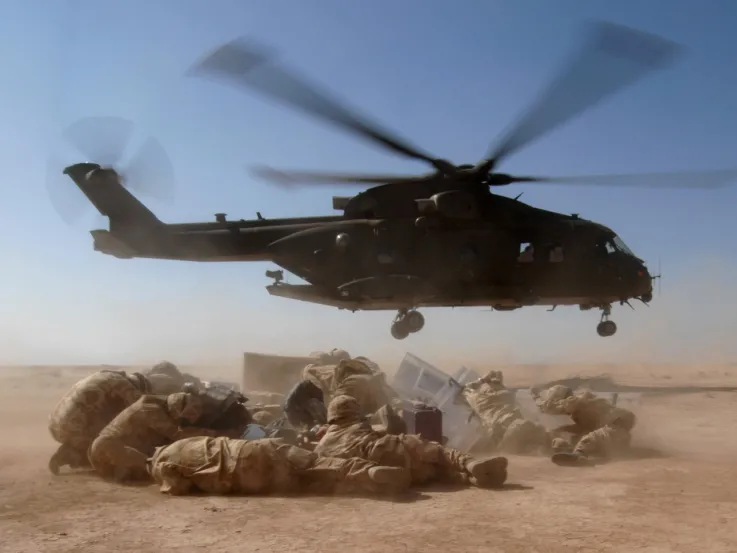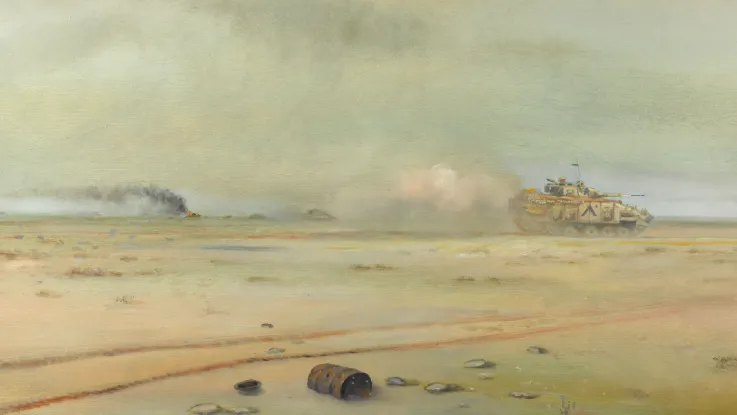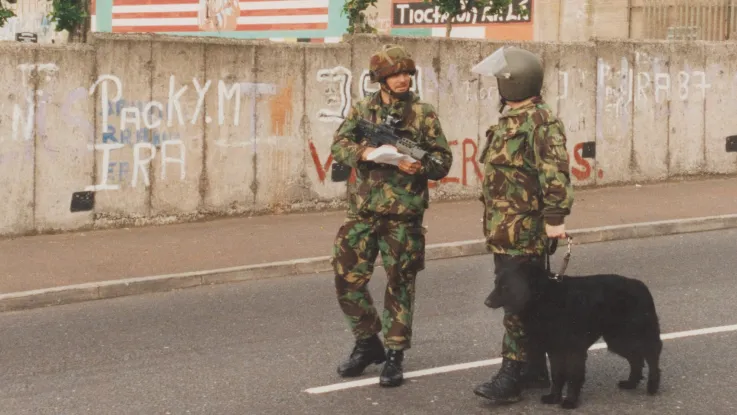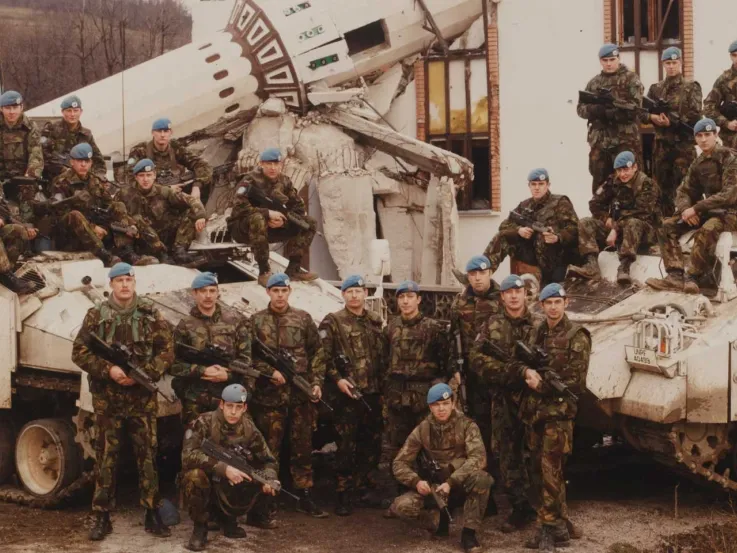Background
After the Al Qaeda attacks on the United States (US) on 11 September 2001, British Prime Minister Tony Blair made a public commitment to stand with his American allies.
Adhering to the North Atlantic Treaty Organisation’s (Nato) tenet that an attack on one member is an attack on all, British forces took part in the operation to oust Al Qaeda and overthrow the Taleban regime in Afghanistan.
US President George W Bush then turned his attention to Iraq’s ruler, Saddam Hussein. During the Gulf War (1990-91), the president’s father, George Bush Senior, had led the coalition which ousted Iraqi forces from Kuwait, but failed to topple the dictator.
Weapons of mass destruction
The Bush Administration claimed that Saddam was actively developing biological and chemical armaments, so-called weapons of mass destruction (WMD), in contravention of international treaties and protocols.
2002 saw the US military preparing for action against Iraq. The pretext for this was Saddam's alleged stockpiling of WMD and his refusal to co-operate fully with United Nations (UN) weapons inspectors.
‘War on Terror’
British military personnel working with the Americans were aware of the plans to broaden the ‘War on Terror’. But Tony Blair was hesitant to fully commit UK forces to the venture against Iraq without parliamentary backing.
This delay limited Britain’s role in the planning phase and led to its forces being less prepared and equipped than they might otherwise have been. The preparations for deployment to the Middle East were also hampered by the British Army's commitments during the UK’s Fire Service industrial dispute in the winter of 2002-03.
Logistics
The preferred option of Britain’s military chiefs was to use Turkish bases and attack Iraq from the north through friendly Kurdish territory. However, the decision was eventually made to attack from the south, using Kuwait as a launch pad for the assault.
The movement of British troops and equipment to Kuwait, which began in earnest in January 2003, was a tremendous logistical challenge for the three branches of the armed services. There were significant shortages and delays in supplying troops with the necessary equipment in time.
Large tented camps were constructed in Kuwait. But last-minute training and planning for the soldiers arriving there was complicated by destructive dust storms and the potential threat from biological and chemical attacks.
‘Shock and Awe’
Despite mounting anti-war protests, Blair finally gained backing in the House of Commons and immediately committed British forces to offensive military action. Within hours, UK special forces were engaged in covert operations inside Iraq, gathering intelligence and locating potential targets.
On 20 March 2003, two days after the parliamentary vote, an ultimatum for Saddam Hussein to leave Iraq expired. The US and its allies launched a full-scale invasion. They adopted a ‘Shock and Awe’ strategy, intending to reduce Iraq’s will to fight through a display of overwhelming force.
Telic
The British deployment in Iraq was termed Operation Telic. The name was derived from the Greek for purposeful or defined action.
British ground forces involved in Telic centred on 1st Armoured Division, commanded by Major General Robert Brims. The division included 16 Air Assault Brigade, 7th Armoured Brigade equipped with Challenger tanks and Warrior armoured fighting vehicles, and 102 Logistics Brigade.
3 Commando Brigade Royal Marines came under the operational command of 1st Armoured Division. Special forces were also deployed along with specialised personnel tasked with locating and making safe WMD.
While they may have served in peacekeeping operations, such as in Bosnia and Kosovo, the majority of British personnel would not have experienced anything like the show of military force that was about to be unleashed.
Attack
US and British engineers breached defensive banks to allow coalition forces to cross into Iraq on the night of 20 March 2003. The following evening, extensive air and missile strikes hit targets throughout Iraq, designed to promote ‘shock and awe’ and neutralise command and control infrastructure.
The Iraqi defences soon collapsed in the face of the main US assault of armoured vehicles supported by artillery, attack helicopters and air strikes.
Baghdad was the key target for US troops, with ‘regime change’ their prime objective. An early objective in securing the route to the capital was to seize the Al Faw peninsula and gain access to the vital port of Umm Qasr.
Coalition forces, including 40 and 42 Royal Marine Commandos, launched a successful assault and secured key sites, including the Rumaila oilfields. The bulk of British armour rolled into Iraq on 21-22 March.
Basra
A key role of British forces was to occupy the ‘Basra Box’, screening the main American advance northwards. To avoid delay and needless casualties, it was decided that Basra - Iraq's second largest city - was not to be occupied immediately. But the surrounding territory had to be secured.
British troops reinforcing and relieving US Marines encountered significant Iraqi resistance and had to deal with increasing numbers of prisoners.
'It was quite shocking to see people on pickup trucks driving at tanks. And, obviously, clearly getting taken out... How little life meant to people who were coming... driving towards armoured vehicles, and having little effect on them, and just getting taken out. And that was obviously the Fedayeen at the time, and the rumour was that a lot of them were high on drugs, and bits and bobs anyway. So that coupled with, you know, martyrdom, probably is the reason they were doing it.'Captain Paul Fagin, 1st Battalion The Irish Guards — 2009
Resistance
Iraqi armour was quickly eliminated and regular Iraqi forces abandoned their bases. However, the Fedayeen - paramilitaries used by Saddam to quell internal unrest - began to mount a significant resistance along with the Ba’athist regime’s secret police, and a handful of foreign fighters centred on Basra and the town of Zubayr.
British units, having suffered casualties, responded to ambushes and sniper fire with aggressive armoured patrols and raids.
Zubayr secured
Using information from anti-regime sympathisers in the area, and with special forces directing precision air strikes on resistance positions, Zubayr was largely secured within a week.
The British established strongpoints controlling the bridges into Basra and used Unmanned Aerial Vehicles, or drones, and special forces to target enemy positions.
Advance continues
On the Al Faw peninsula, 3 Commando Brigade took the town of Abu Al-Khasib with air support and tanks of the Royal Scots Dragoon Guards.
While the bulk of 16 Air Assault Brigade secured the southern oilfields, troops of 7 Royal Horse Artillery (7RHA) and the Parachute Regiment’s Pathfinders Platoon were moving north in support of the main US force, meeting heavy resistance at Nasiriyah.
They engaged Iraqi forces north of the al-Hammar Canal towards the River Euphrates. 7RHA engaged in artillery duels with Iraqi forces as reconnaissance patrols, supported by air strikes, probed their defences.
Special forces
In the west of Iraq, special forces units, supported by the Royal Air Force, were part of an operation to eliminate Iraqi mobile Scud missiles.
There turned out to be no missiles. But the raids, which penetrated close to Baghdad, led the Iraqi leadership to divert attention and resources away from the main coalition attack.
Drive on Baghdad
Within four days of the start of the operation, the US Army was at Najaf, some 95km (60 miles) from Baghdad, while US Marines were pressing north along a different route towards Kut.
After several days of consolidating their position, while attacking Iraqi forces with artillery and aircraft, US forces engaged the Iraqi Republican Guard divisions around Baghdad. By 4 April 2003, they had seized the city outskirts, including the airport.
Basra secured
Back in the south, by 6 April, British commanders judged that conditions were right to enter Basra in strength. Armoured probes encountered only limited resistance and so these were escalated into a full-scale assault.
British troops occupied strategic locations with minimal casualties and, with Saddam’s loyalists dispersing, they were initially welcomed by much of the civilian population.
British forces had to contend with widespread looting in the city, but order was gradually restored. Contacts were made with local leaders and attempts were made to improve power, food and water supplies.
‘My fellow Americans, major combat operations in Iraq have ended. In the battle of Iraq, the United States and our allies have prevailed. And now our coalition is engaged in securing and reconstructing that country.’President George W Bush — May 2003
Mission accomplished?
By 8 April 2003, US troops had secured the approaches to Baghdad. The following day, crowds gathered in the centre of the city to welcome coalition forces and destroy symbols of the old regime.
By now, the west and north of Iraq had largely been secured. A few days later, the northern cities of Tikrit, Mosul and Kirkuk fell to coalition troops. Meanwhile, Saddam had gone on the run. He would eventually be caught and executed in 2006.
On 1 May, President Bush addressed US military personnel and the world’s media on the aircraft carrier 'USS Abraham Lincoln', stating that combat operations were over.
But attempts to establish stability failed. Sectarian violence and an insurgency against the occupation soon ensued. British soldiers would end up staying in Iraq for another six years.






















